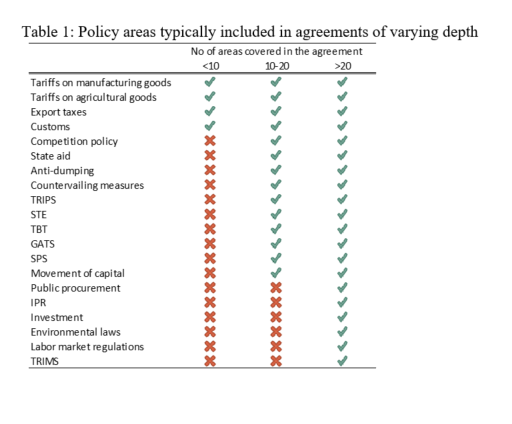If a trade economist were abruptly woken up by somebody shouting, “preferential trade agreements” (PTAs), their first thought is likely to be “trade creation among participants and trade diversion away from those left out.” That is a measure of the influence of Jacob Viner’s classic book The Customs Union Issue on the profession, on the policy debate and on our attitude towards PTAs.
Brexit and the renegotiation of NAFTA have renewed interest in the impact of trade agreements and the consequences of undoing them. In a recent paper, Mattoo, Mulabdic and Ruta (2017) and column (VOXEU), we use new information on the content of PTAs to examine their trade effects.
Since the early 1990s, PTAs have grown in number and reach. Among the agreements in place today, the number grew from only about 20 in 1990 to 279 at the end of 2015. Viner’s analysis was developed in a world where trade agreements were “shallow” and focused only on bilateral tariff liberalization. More recent PTAs are “deep” and cover also behind-the-border policy areas, such as services, investment, competition and other regulatory issues. (Table 1).
Note: a provision is shown as included in a particular category if it is covered by more than 60% of agreements in that category
Our research finds that “deep agreements” have boosted trade among members by as much as 44 percent compared to shallow PTAs. Because behind-the-border reforms take time to implement, it takes on average about two years for deep agreements to increase trade flows (Figure 2).
While shallow PTAs tend to divert trade from non-members, deep agreements do not. In fact, disciplines on services, competition policy, subsidies and standards can diminish discrimination against all trading partners, and thereby also enhance trade vis-à-vis outsiders. Specifically, a standard deviation increase in the average depth of the partner’s trade agreements with other countries increases bilateral trade by around 19 percent.
Consider three trade agreements of varying depth, as measured by the policy areas covered. A shallow agreement such as Peru-Chile increased bilateral trade by an estimated 10 percent, but had a negligible impact on non-members. Korea-US, a medium depth PTA, increased trade by 14 percent and raised imports from outsiders by 4 percent. The deepest agreement in our sample, the EU, increased trade flows among members by 44 percent, while exports from non-EU countries would have been 30 percent lower in its absence.
Because they enhance trade between members and have a positive spillover effect on trade with non-members, deep agreements are public goods. Undoing them would hurt both insiders and outsiders.





Join the Conversation